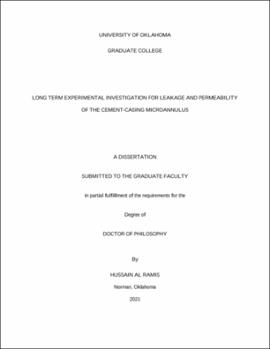| dc.contributor.advisor | Teodoriu, Catalin | |
| dc.contributor.author | Al Ramis, Hussain | |
| dc.date.accessioned | 2021-05-14T20:21:39Z | |
| dc.date.available | 2021-05-14T20:21:39Z | |
| dc.date.issued | 2021-05-14 | |
| dc.identifier.uri | https://hdl.handle.net/11244/329586 | |
| dc.description.abstract | The oil and gas industry is the primary provider of energy globally. Energy extraction from wells takes place through several stages, such as exploration, drilling and production, and then plugging and abandonment. The ISO, API, and NORSOK standards require oil and gas wells to be isolated such that any fluid leakage or pressure does not reach the surface. This isolation is achieved by using well barriers composed principally of cement plugs.
The integrity of the cement used to isolate the wells, however, is repeatedly compromised by preventable gas leaks. In the long term, this unwanted flow constitutes a safety hazard and is detrimental to the environment.
The objective of the present quantitative research study is to experimentally identify and understand the fluid flow path that causes leakage in the cement. This study is conducted in two stages. First, the system permeability of internally cemented pipe (specimen) is determined using pressure decline experiments. The specimens were subjected to an air pressure of 50 psig at the inlet and atmospheric pressure at the outlet. After closing the air supply valve, the inlet pressure was measured and recorded as a function of time. System permeability is calculated using various estimation methodologies, including the pulse decay method. Second, the data collected are used to understand the behavior and direction of the microannulus. A new method is developed to measure the gap between cement and casing. This technique visually measures the gap (micro-annulus) and relates the measurements to the flow rate through the specimen. The main test variables were the hydration time and specimen length. The results show that system permeability is more affected by hydration time than the specimen length. Thus, cement age is more indicative of the gap size than cement-pipe contact length. | en_US |
| dc.language | en_US | en_US |
| dc.rights | Attribution 4.0 International | * |
| dc.rights.uri | https://creativecommons.org/licenses/by/4.0/ | * |
| dc.subject | Drilling | en_US |
| dc.subject | Cement-Casing Microannulus | en_US |
| dc.subject | Well Integrity | en_US |
| dc.subject | Cement | en_US |
| dc.title | Long term experimental investigation for leakage and permeability of the cement-casing microannulus | en_US |
| dc.contributor.committeeMember | Harwell, Jeffrey | |
| dc.contributor.committeeMember | Amani, Mahmood | |
| dc.contributor.committeeMember | Fahs, Mashhad | |
| dc.contributor.committeeMember | Ahmed, Ramadan | |
| dc.contributor.committeeMember | Salehi, Saeed | |
| dc.contributor.committeeMember | Mahmoo | |
| dc.date.manuscript | 2021-05-14 | |
| dc.thesis.degree | Ph.D. | en_US |
| ou.group | Mewbourne College of Earth and Energy::Mewbourne School of Petroleum and Geological Engineering | en_US |

